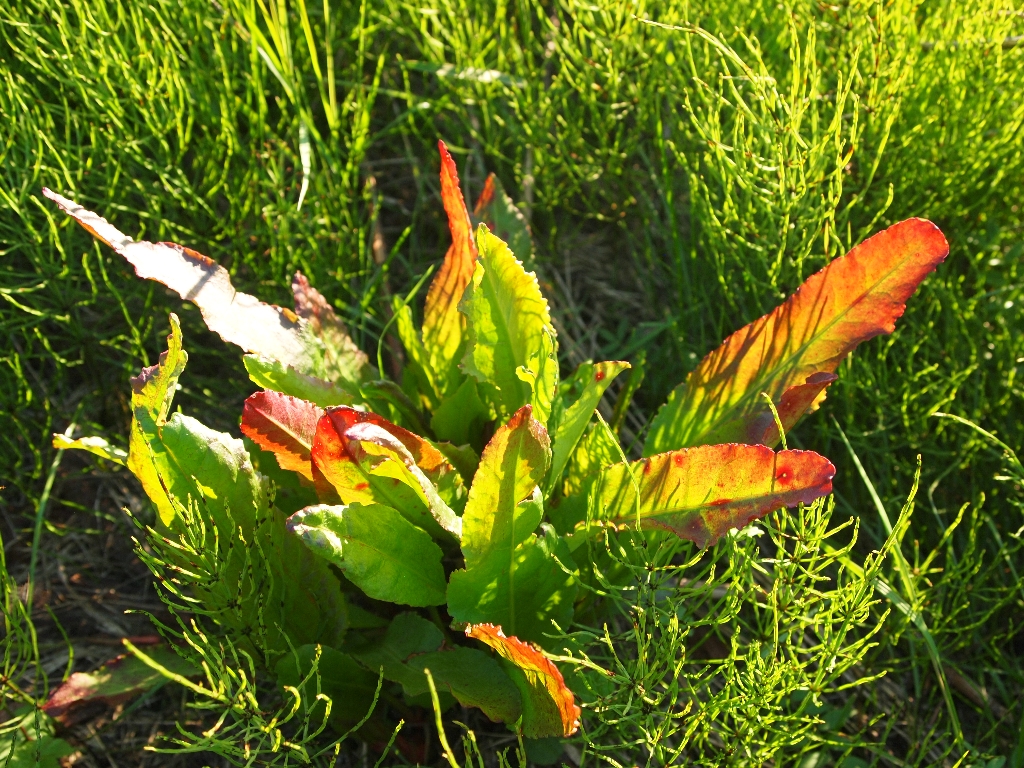
Sourdock (Rumex arcticus) is also called quaġaq (with regional dialect variants: -ġak, -ġat) in Iñupiaq. This striking plant can be found on the tundra, especially in the marshy areas.
Sourdock's most recognizable feature is its tall, thin stalk that is often bright red in color. The stalk is a short-lived feature. A more standard part of the plant to see during tundra exploring is its large, flat leaves that can be tipped in bright red.
The leaves are the most commonly eaten portion of the plant. Typically people will freeze or cook them before consuming. This reduces the amount of oxalic acid in the leaves, which can be harmful if eaten in large amounts. Small amounts of raw leaves are not considered harmful, but always exercise caution when consuming.
Sourdock has the ability to be used as a laxative. Only small amounts of the plant are needed to help cure stomach and bladder troubles. It has also been used to cure hangovers and overindulgement.
Sources:
Sourdock's most recognizable feature is its tall, thin stalk that is often bright red in color. The stalk is a short-lived feature. A more standard part of the plant to see during tundra exploring is its large, flat leaves that can be tipped in bright red.
The leaves are the most commonly eaten portion of the plant. Typically people will freeze or cook them before consuming. This reduces the amount of oxalic acid in the leaves, which can be harmful if eaten in large amounts. Small amounts of raw leaves are not considered harmful, but always exercise caution when consuming.
Sourdock has the ability to be used as a laxative. Only small amounts of the plant are needed to help cure stomach and bladder troubles. It has also been used to cure hangovers and overindulgement.
Sources:
- Jones, Anore. Plants That We Eat: Nauriat Nigiñaqtuat. Univ. of Alaska Press, 2010.
- Garibaldi, Ann. Medicinal Flora of the Alaska Natives: a Compilation of Knowledge... Alaska Natural Heritage Program, Environment and Natural Resources Institute, University of Alaska Anchorage, 1999.
- Schofield, Janice J. Discovering Wild Plants: Alaska, Western Canada, the Northwest. Alaska Northwest Books, 1995.
Is there something we missed for this itinerary?
Itineraries across USA

Acadia

Arches National Park

Badlands

Big Bend

Biscayne

Black Canyon Of The Gunnison

Bryce Canyon

Canyonlands

Capitol Reef

Carlsbad Caverns

Channel Islands

Congaree

Crater Lake

Cuyahoga Valley

Death Valley

Dry Tortugas

Everglades

Gateway Arch

Glacier

Grand Canyon

Grand Teton

Great Basin

Great Smoky Mountains

Guadalupe Mountains

Haleakalā

Hawaiʻi Volcanoes

Hot Springs

Indiana Dunes

Isle Royale

Joshua Tree

Kenai Fjords

Kobuk Valley

Lassen Volcanic

Mammoth Cave

Mesa Verde

Mount Rainier

North Cascades

Olympic

Petrified Forest

Pinnacles

Rocky Mountain

Saguaro

Shenandoah

Theodore Roosevelt

Virgin Islands

Voyageurs

White Sands

Wind Cave

Yellowstone

Yosemite

Zion